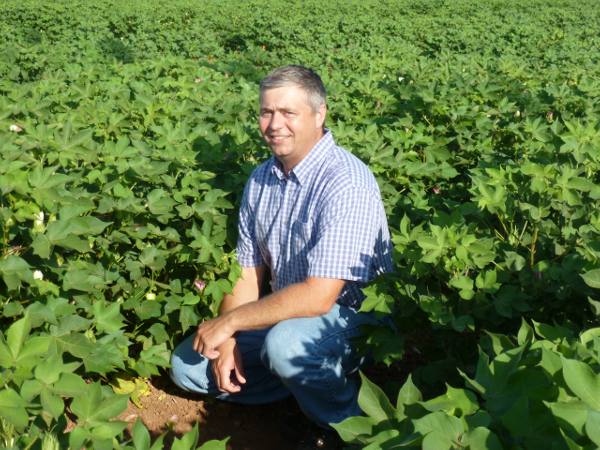
One advantage of a public breeding program for cotton is the diverse germplasm available to screen for a variety of traits that may increase the pest resistance spectrum, drought and other stress tolerance and options that fit specific growing conditions.
“But we also want to make certain we develop cultivars that can compete with commercial varieties in yield and fiber quality,” says Steve Hague, a Texas A&M AgriLife Research cotton breeder at College Station.
��“Ideally, we would develop something that private industry would pick up. We are not in the cottonseed marketing business.”
Hague says private cottonseed companies develop and market excellent varieties that are “incredibly productive. But if we want to keep pushing yield and quality, we need public breeding, too.”
If you are enjoying reading this article, please check out Southwest Farm Press Daily and receive the latest news right to your inbox.
Hague looks for traits that fit a special geography. He says a different spectrum of insect pests may be of more concern to East, South and Central Texas than what farmers typically face in West Texas. Fleahoppers and whiteflies, for instance, have been troublesome in recent years.
“I don’t know how much effort private cottonseed companies are putting into developing fleahopper resistance since it is a regional pest.
“We plant earlier here than they do in the Plains. The Texas High Plains makes a lot of cotton in September and October; we are typically out of the field by then. So just the day length differences alone can cause unique physiological reactions.”
Stress factors differ
Drought and stress tolerance also may vary with different growing seasons. “Stress can be a matter of timing,” Hague says. “Delaying irrigation by just a day can initiate stress on a cotton plant. Obviously, we would all like to have cotton that could tolerate extremely dry soil conditions, but if a grower had cotton that could handle minor drought stress, it would be extremely beneficial. If irrigation could be delayed by two or three days without a yield loss, it would, over the course of a growing season, save a lot of water.”
Hague and one of his graduate students, Austin Terhune, are looking for this type of drought stress tolerance through screening and breeding efforts.
He says those special problems may be too isolated or too infrequent to justify investment by private companies. “They would have problems targeting secondary pests and making a profit on (resistant) products that may or may not be needed in a particular year. Weeds and worms, on the other hand, will always be an issue.”
Hague is screening germplasm lines, some of which have been in the Texas A&M collection since the 1930s and 1940s. Entomologist Allen Knutson also has been began screening for insect resistance.
“We’re looking at native traits for fleahopper resistance, not transgenic breeding,” Hague says. “And we are seeing some significant differences – 30 percent to 40 percent advantages in terms of fruit retention.”
The challenge will be to get that resistance into elite lines and available to growers. “When we find resistance we have to incorporate it into an elite background. Otherwise, it’s like putting a high-end speaker system in an old jalopy.”
He’s identified “some promising material that competes with commercial lines and sometimes beats them. And the earlier generations are better than the later ones. “We’re excited about what some of these lines will do as we advance them.”
He expects little from 2013 trials, however. “We’ve had limited water for irrigation and many of our dryland locations are suffering from drought, so we will not get a good look at yield potential in many of our tests this year.”
He also recognized the efforts of graduate student Laura Ann McLoud who has “logged a lot of hours looking at plants and documenting changes.” McLoud, a PhD candidate, is a Cotton Incorporated Fellow. “We have had good support from Cotton Incorporated,” Hague says. “Without that, the program would not move forward.”
He says working on conventional cotton varieties also may benefit some farmers. “I think in a lot of ways we have better conventional tools now than we did before the introduction of transgenics,” he says. “Conventional cotton offers an alternative, and I would like to see more of them for sale. Not many companies currently offer conventional cotton.”
He concedes that managing conventional cotton will be more difficult than is the case for herbicide resistance varieties. “But it could be profitable on low input acreage, dryland fields or fields with limited irrigation water—places where a farmer will not be assured of making a crop.”
He says breeding conventional varieties moves a bit faster than for genetically engineered breeding. “We can respond quicker with a greater amount of genetic diversity because we aren’t having to backcross or work within a closed and genetically narrow population.”
He adds that native resistance—to something like fleahoppers or whiteflies—can be matched with Bt and herbicide resistance to offer more options.
“I’d also like to see if we can find something with an effect on lygus bugs. But that is pure speculation at this point.”
He says getting the cotton genome fully mapped will improve opportunities for cotton breeders. “The challenge is identifying the genes that match physical traits. That’s where graduate students are essential. They do a lot of the grunt work and they approach their work with novel ideas.”
And it’s not a quick process. “We don’t develop a new variety in one or two years; it’s usually a decade-long process. From start to commercialization, we anticipate 10 years. We’re about 80 percent there. I am excited about how some of our materials look.”
You may also like:
Cotton breeding pushing through yield barriers
Public breeding efforts concentrate on special issues
AgriLife Research peanut breeding program offers new varieties
About the Author(s)
You May Also Like






